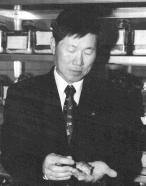 |
Mother Nature swiftly
changed their lives. And, now, tremendous
effort has gone into helping the North Dakota
and Minnesota flood victims regain what was
lost. As the following stories will relate,
help has been
arriving in many forms, through individuals,
corporations, and the government.(Dr. Kap Lee with a laboratory
friend)
Lee saves valuable rodents
|
Tending to rodents' needs during
the North Dakota and Minnesota floods might seem
trivial. Or heroic depending on how you look at it.
Amidst the flood damage frenzy,
during which most of the city evacuated, Dr. Kap Lee
stayed for the sake of 5,000 rats, mice, hamsters,
and rabbits. The animals, whose home is at the
University of North Dakota, are cherished research
subjects for cancer, diabetes, and other diseases.
Researcher David Hein had invested
years of work in the animals, especially in the
hamsters kept in closed colonies. Dr. Lee,
director of the Center for Biomedical Research,
said, "These hamsters are very valuable. If he
loses them, he is never going to get them back in his
lifetime. So we have to take care of the animals the
best we can."
During the three weeks the
university was closed, Dr. Lee voyaged to the
research laboratory by boat. Severed power forced Dr.
Lee to work only with a flashlight, while he
performed duties such as changing bedding and feeding
the animals. Feeding was difficult with no running
water; Dr. Lee and his small staff had to carry 900
gallons of bottled water up four flights of stairs to
the laboratory.
According to Dr. Lee, maintaining a
routine of 12 hours of light followed by 12 hours of
darkness was essential for the nocturnal creatures.
In the windowless laboratory, Dr. Lee managed to shed
light with lots of battery-powered lanterns.
Although the University of North
Dakota endured extensive flood damage, Dr. Lee says
he hopes it is fully functional by the fall.
Holly Ann Suzik